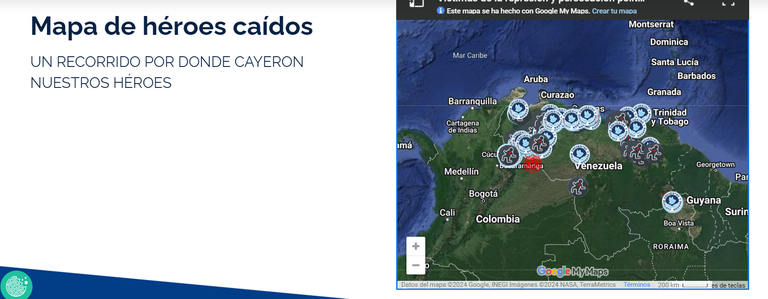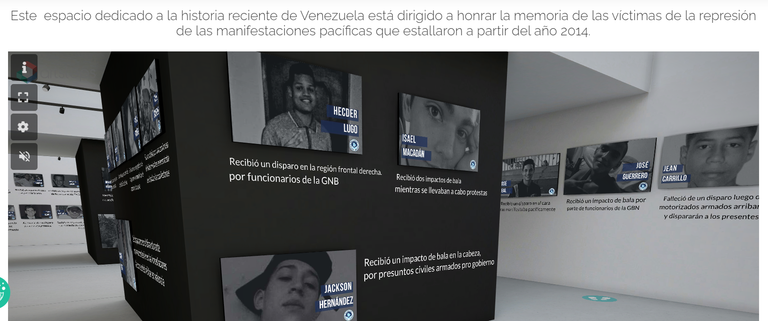Un monumento a la memoria - Museo en Realidad Virtual dedicado a las víctimas por persecución política en Venezuela.

Cada país tiene su propia historia, y en ellos, lamentablemente, han ocurrido historias dolorosas que más tarde se han inmortalizado a través de esculturas, museos, rituales, fechas conmemorativas.
Estos tributos tienen la intención de honrar la vida de aquellas personas que se vieron afectadas por la guerra, el conflicto armado, los desastres provocados por la naturaleza o por el hombre.
Las cifras registradas de fallecidos en estos eventos son importantes y necesarias para tener una idea del impacto de lo ocurrido. Sin embargo, es importante pensar, no solo en función de números sino en función de las historias personales, sus nombres y apellidos, familias y amigos afectados. Solo así, dimensionamos la verdadera magnitud de lo perdido.
Esta comprensión nos permite ser más sensibles a la historia humana, al dolor y al sufrimiento al que se han visto sometidos grupos de personas, por sus creencias religiosas, su raza, su ideología, o por el simple hecho azaroso de haber estado en el lugar incorrecto, en el momento incorrecto. Esto último, por ejemplo, nos hace conectar con la idea de que "a cualquiera le pudo haber pasado esto", lo que nos hace ser partícipes de la situación desde un lugar más empático, humano, conectando con el dolor del otro.
Los museos de la memoria dignifican no solo las vidas de estas personas, que en muchas ocasiones fueron deshumanizadas, sino también cumplen con una función reparadora, para la familia, la ciudad, el país y la historia humana en si misma. Es una manera de inmortalizar las injusticias, la violencia, y de enmarcar en un lugar y espacio el trabajo arduo de la defensa de los Derechos Humanos.
En el mundo tenemos distintos Museos de la Memoria, el Hiroshima Peace Memorial Museum, los museos del Holocausto en Israel, el Museo del Apartheid en Sudáfrica, el museo del 11-S en New York, el museo de Montevideo sobre la tragedia de Los Andes de 1972, entre otros.
En Venezuela se han realizado tributos espontáneo, realizados por los propios ciudadanos, en memoria de las personas que han fallecido en las protestas de las últimas dos décadas. He visto diferentes tributos, el último que vi, los nombres de los fallecitos escritos con tinta blanca en la carretera, una persona graba en un carro andando, los segundos pasan y vemos más y más nombres. Impresiona y moviliza esto que es tanto un tributo como una protesta.

En la memoria colectiva y en los dispositivos móviles tenemos un álbum de nuestra historia. Ojalá, eventualmente, tener espacios físicos de recuerdo, reflexión y encuentro. Por sanidad mental el humano olvida muchas cosas, pero hay historias que no debemos olvidar.
Comparto un descubrimiento accidental de hace un par de días. Un museo de la memoria, en realidad virtual, dedicado a las víctimas de asesinatos por persecución política en Venezuela. Como dice en su página web, para honrar la memoria de las víctimas de la represión de las manifestaciones pacíficas que estallaron entre el 2014-2019. Este es un proyecto de la ONG Justicia Encuentro y Perdón, en alianza con la red global de la diáspora de Venezuela. Es sumamente triste que la historia reciente, es la historia presente. Les comparto el enlace del museo -> https://redglobalvenezuela.org/museo-de-la-memoria/

Las imágenes de esta publicación no son mías. Las obtuve de https://redglobalvenezuela.org/museo-de-la-memoria/

Every country has its own history, and in them, unfortunately, painful stories have occurred that later have been immortalized through sculptures, museums, rituals, commemorative dates.
These tributes are intended to honor the lives of those who were affected by war, armed conflict, natural or man-made disasters.
The recorded numbers of those who died in these events are important and necessary to get an idea of the impact of what happened. However, it is important to think not only in terms of numbers but also in terms of personal stories, names and surnames, families and friends affected. This is the only way to measure the true magnitude of what has been lost.
This understanding allows us to be more sensitive to human history, to the pain and suffering to which groups of people have been subjected, because of their religious beliefs, their race, their ideology, or because of the simple random fact of having been in the wrong place at the wrong time. The latter, for example, makes us connect with the idea that "this could have happened to anyone", which makes us participate in the situation from a more empathetic, human point of view, connecting with the pain of the other.
The memory museums dignify not only the lives of these people, who in many occasions were dehumanized, but also fulfill a reparative function, for the family, the city, the country and human history itself. It is a way to immortalize the injustices, the violence, and to frame in a place and space the arduous work of the defense of Human Rights.
In the world we have different Museums of Memory, the Hiroshima Peace Memorial Museum, the Holocaust museums in Israel, the Apartheid Museum in South Africa, the 9/11 museum in New York, the museum of Montevideo on the tragedy of the Andes in 1972, among others.
In Venezuela there have been spontaneous tributes, made by the citizens themselves, in memory of the people who have died in the protests of the last two decades. I have seen different tributes, the last one I saw, the names of the deceased written in white ink on the road, a person recording in a car, the seconds pass and we see more and more names. This is both a tribute and a protest, impressive and moving.

In the collective memory and on mobile devices we have an album of our history. Hopefully, eventually, we will have physical spaces of remembrance, reflection and encounter. For mental health human beings forget many things, but there are stories that we should not forget.
I share an accidental discovery of a couple of days ago. A museum of memory, in virtual reality, dedicated to the victims of assassinations due to political persecution in Venezuela. As it says on its website, to honor the memory of the victims of the repression of peaceful demonstrations that broke out between 2014-2019. This is a project of the NGO Justice Encounter and Forgiveness, in alliance with the global network of the Venezuelan diaspora. It is extremely sad that recent history, is present history. I share with you the link to the museum -> https://redglobalvenezuela.org/museo-de-la-memoria/

The images in this publication are not mine. I got them from https://redglobalvenezuela.org/museo-de-la-memoria/
Posted Using InLeo Alpha
